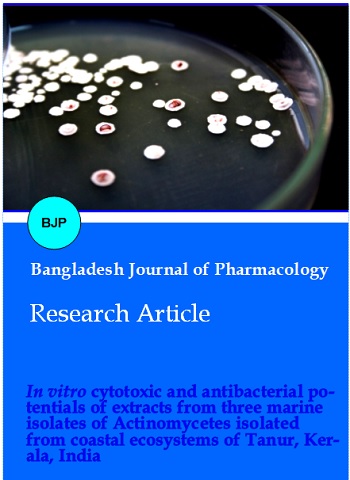In vitro cytotoxic and antibacterial potentials of extracts from three marine isolates of Actinomycetes isolated from coastal ecosystems of Tanur, Kerala, India
DOI:
https://doi.org/10.3329/bjp.v10i1.21085Keywords:
Anticancer, Antimicrobial, HeLa cells, Marine Actinomycetes, MTT assay, TLCAbstract
Three Actinomyctes with potential bioactivity are successfully isolated from the marine water samples and identified as Prauserella marina, Streptomyces sindenensis and S. spiroverticillatus. The ethyl acetate extracts from the three Actinomycetes are found to have significant bioactivity. The highest anti-bacterial activity was given by the extract from P. marina on B. cereus showing 28 mm of zone of inhibition. Cytotoxicity screening of the crude extracts using 3-(4, 5-dimethylthiazol-2yl)-2, 5-diphenyl tetrazolium bromide (MTT) cell viability assay revealed that extract from P. marina noticeably effected the viability of the human cervical cancer cell grown in vitro. Thin layer chromatography of the crude extract with methanol and chloroform (8:2) as solvent system yielded three distinct fractions, of which fraction with Rf value 0.8 resulted in 77, 68, 54 and 40% growth inhibition of HeLa cells at 15, 10, 5, 2.5 µg/mL, respectively with the IC50 value as 3.3 µg/mL. HPLC analysis of the fraction resulted in single major peak at 3.7 min.
Downloads
525
255 Read
382

Published
How to Cite
Issue
Section
License
Authors who publish with this journal agree to the following terms:
- Authors retain copyright and grant the journal right of first publication with the work simultaneously licensed under a Creative Commons Attribution License that allows others to share the work with an acknowledgement of the work's authorship and initial publication in this journal.
- Authors are able to enter into separate, additional contractual arrangements for the non-exclusive distribution of the journal's published version of the work (e.g., post it to an institutional repository or publish it in a book), with an acknowledgement of its initial publication in this journal.
- Authors are permitted and encouraged to post their work online (e.g., in institutional repositories or on their website) prior to and during the submission process, as it can lead to productive exchanges, as well as earlier and greater citation of published work (See The Effect of Open Access).
